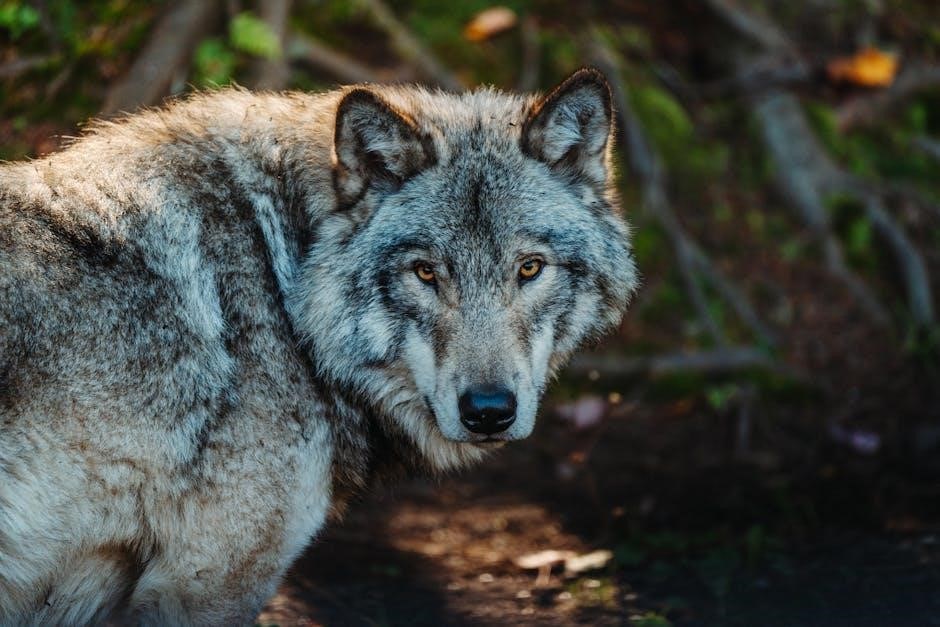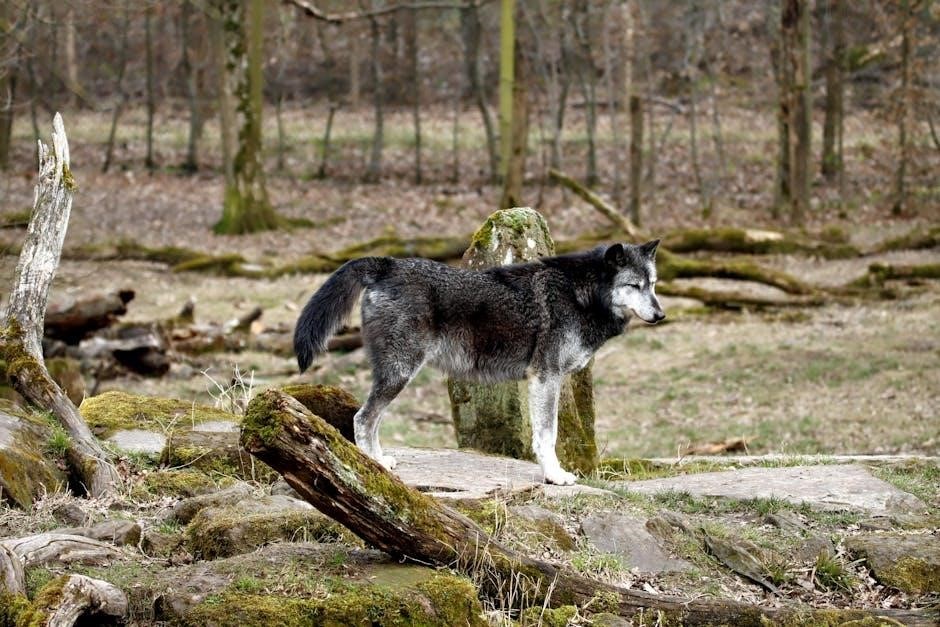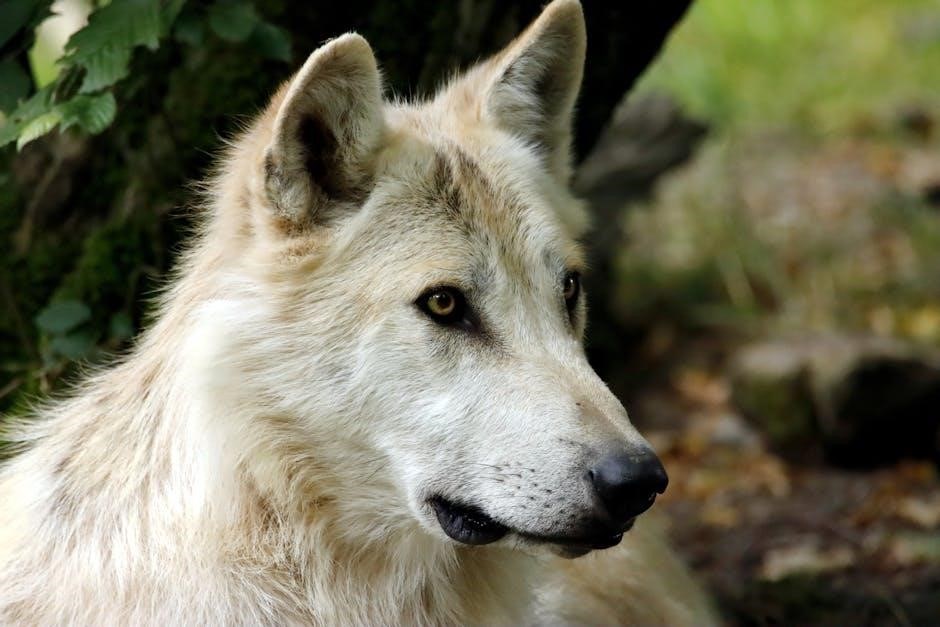Wolf leadership is a complex yet fascinating phenomenon, guiding pack dynamics with precision. It encompasses strategic survival techniques, social bonding, and a delicate balance between strength and empathy.
Understanding the Role of a Wolf Leader
Wolf leaders play a pivotal role in guiding their pack, ensuring survival and harmony. They are responsible for making strategic decisions, such as hunting locations and territory defense. A leader’s strength, intuition, and ability to maintain order are crucial for the pack’s success. Their role extends beyond dominance, involving emotional balance and the well-being of all members.
Leadership in wolves is not just about authority but also about fostering unity and trust. The leader must adapt to challenges, resolve conflicts, and teach essential skills, ensuring the pack thrives in diverse environments. Their guidance is vital for the pack’s resilience and longevity, making them the cornerstone of wolf society.
The Evolution of Wolf Pack Dynamics
Wolf pack dynamics have evolved over centuries, shaped by environmental pressures and social needs. Early wolf societies likely formed for survival, with cooperation enhancing hunting success and territory defense. Over time, hierarchical structures emerged, emphasizing clear roles and communication to maintain order.
This evolution fostered a balanced system where leaders guide, subordinates support, and younger wolves learn essential skills. Adaptability in pack dynamics has been key to their endurance, reflecting their ability to thrive in diverse habitats and challenges throughout history.

Wolf Pack Hierarchy
A wolf pack operates under a strict hierarchical structure, led by an alpha pair, followed by beta and subordinate wolves, ensuring survival and stability within the group.
The Alpha Wolf: Responsibilities and Characteristics
The alpha wolf is the pack’s leader, guiding survival strategies and maintaining order. They are responsible for protecting territory, leading hunts, and resolving conflicts. Alphas exhibit strength, confidence, and emotional stability, earning respect through consistent leadership. Their role includes teaching younger wolves and ensuring the pack’s social structure remains intact. By balancing authority with compassion, alpha wolves foster unity and trust, essential for the pack’s prosperity. Their ability to adapt and make decisive actions ensures the pack’s survival in challenging environments;
The Beta Wolf: Supporting the Alpha
The beta wolf serves as the alpha’s trusted deputy, assisting in decision-making and maintaining pack discipline. They often handle daily operations, such as coordinating hunts and resolving minor disputes. Beta wolves are highly loyal and experienced, providing stability when the alpha is absent. Their role involves mentoring subordinate wolves and reinforcing the pack’s social hierarchy. By supporting the alpha, beta wolves ensure the pack’s cohesion and readiness to face challenges. Their leadership skills prepare them to step into the alpha role if necessary, maintaining continuity and strength within the pack.
Subordinate Wolves: Their Role in the Pack
Subordinate wolves play a vital role in the pack’s survival, contributing to hunting, pup-rearing, and territory defense. They learn from higher-ranking members, refining their skills and understanding pack dynamics. Subordinates often take on specific tasks based on their strengths, such as scouting or hunting. Their loyalty and cooperation are essential for the pack’s success. While they may not hold leadership roles, their adaptability and willingness to support the alpha and beta wolves ensure the pack’s stability and effectiveness in challenging environments.

Communication in Wolf Packs
Communication in wolf packs involves vocalizations, body language, and scent marking, each serving unique roles in maintaining social order and strengthening pack bonds effectively.
Vocalizations: How Wolves Convey Messages
Wolves use a variety of vocalizations to communicate, including howls, barks, whines, and growls. Howls serve to locate pack members, reinforce social bonds, and establish territory. Barks often signal alarm or excitement, while whines convey submission or a request for food. Growls and snarls express aggression or assert dominance. These vocal cues are essential for maintaining order and coordination within the pack, allowing leaders to guide and unite members effectively through clear auditory signals.
Body Language: Key Signals for Leadership
Body language plays a crucial role in wolf leadership, conveying authority and maintaining order within the pack. Dominant wolves display confident postures, such as standing tall with ears up and tails held high. Submissive wolves lower their heads, tuck their tails, and often roll onto their backs to signal deference. Aggressive behaviors, like bared teeth or stiffened fur, warn of potential conflict. These non-verbal cues ensure clear communication, reinforcing the leader’s role and promoting pack harmony through visible expressions of dominance and submission.
Scent Marking: Establishing Territory and Authority
Scent marking is a primary form of communication for wolves, serving to establish territory and reinforce authority. Alpha wolves use urine and feces to leave pheromones, signaling their identity and dominance. These marks warn other packs to stay away and remind subordinate wolves of the leader’s presence. Beta wolves may also scent mark, but less frequently, while lower-ranking wolves rarely do. This practice ensures territorial boundaries are respected and maintains social order, with the alpha’s scent acting as a powerful symbol of leadership and pack cohesion. It is a vital tool for asserting dominance and stabilizing the hierarchy.

Social Bonding and Trust
Social bonding is vital for pack cohesion, fostering trust and cooperation among members. Wolves build strong relationships through shared activities, mutual respect, and loyalty, ensuring survival and unity.
The Importance of Loyalty in a Wolf Pack
Loyalty is a cornerstone of wolf pack dynamics, ensuring unity and collective survival. It strengthens bonds among members, fostering trust and cooperation. A loyal pack adheres to the leader’s guidance, reducing conflicts and enhancing hunting success. This unwavering dedication also protects vulnerable members, such as pups, and defends territory against threats. Loyalty ensures stability, allowing the pack to thrive in challenging environments. It is a vital trait that reinforces the pack’s social structure and ensures its longevity.
Building Trust Among Pack Members
Building trust within a wolf pack is essential for its survival and harmony. Consistent leadership and reliability from the alpha wolf establish a foundation of trust. Open communication through body language and vocalizations ensures transparency, while shared responsibilities like hunting and pup-rearing strengthen bonds. Trust fosters cooperation, allowing pack members to rely on one another during challenges. This mutual confidence enhances the pack’s resilience and unity, ensuring they thrive together in the wild.
Submission and Dominance: Maintaining Order
Submission and dominance are crucial in maintaining order within a wolf pack. Dominant wolves assert their roles through confident body language and assertive behaviors, while submissive wolves yield to establish harmony. This hierarchy ensures clear communication and reduces conflict. Leaders reinforce their status by guiding decisions and mediating disputes, creating a stable environment. Submission from lower-ranking members acknowledges the leader’s authority, fostering unity and cooperation. This dynamic balance prevents chaos and strengthens the pack’s overall cohesion and survival capabilities in the wild.

Hunting Strategies
Hunting strategies involve coordinated attacks, led by experienced leaders, ensuring efficient prey capture. These methods are vital for survival and teach younger wolves essential skills.
Coordinated Hunting Techniques
Wolves employ sophisticated strategies during hunts, relying on teamwork and communication. Leaders orchestrate attacks, using vocalizations and body language to direct the pack. Flanking maneuvers and ambushes are common, with alpha and beta wolves leading the charge. The pack works in unison, driving prey toward designated hunters. This synchronized effort maximizes efficiency, ensuring successful outcomes. Young wolves learn these techniques through observation and practice, honing their skills under experienced guidance. Coordinated hunting is a testament to the pack’s unity and the leader’s strategic prowess, vital for survival in challenging environments.
The Leader’s Role in Hunting Success
The leader plays a pivotal role in hunting success, orchestrating strategies and ensuring coordination. They assess prey, assign roles, and execute plans with precision. By maintaining discipline and focus, the leader maximizes the pack’s efficiency. Their experience and intuition guide the group, adapting tactics as needed. Effective communication and decisive actions under pressure are key traits. The leader’s ability to read the environment and prey behavior is crucial, often determining the outcome. Their leadership ensures the pack’s survival, reinforcing their importance in hunting dynamics.
Teaching Young Wolves to Hunt
Teaching young wolves to hunt is a critical responsibility of pack leaders. They demonstrate stalking, chasing, and killing techniques, ensuring pups learn essential survival skills. Leaders start with simple tasks, gradually increasing difficulty. Positive reinforcement, such as praise or food rewards, encourages learning. The pack’s survival depends on this education, making it a systematic process. Leaders also adapt teaching methods to individual pups’ abilities, fostering confidence and competence. This hands-on mentorship ensures the next generation is prepared to contribute to the pack’s hunting success and overall survival.

Conflict Resolution
Wolf leaders mediate disputes within the pack, ensuring harmony and unity. Their role is crucial in resolving conflicts to maintain pack stability and survival.
Handling Disputes Within the Pack
Disputes within a wolf pack often arise from resource competition or hierarchical challenges. A skilled leader addresses these conflicts calmly, using vocalizations and body language to restore order. The alpha may intervene by asserting dominance or mediating disputes to prevent escalation. Submission signals from subordinate wolves help maintain balance. In rare cases, physical confrontations occur, but the leader’s presence typically deters prolonged aggression. Effective conflict resolution strengthens pack cohesion and ensures survival, highlighting the leader’s crucial role in maintaining harmony.
Disciplining Pack Members
Disciplining pack members is essential for maintaining order and respect within the hierarchy. Leaders use assertive yet controlled measures, such as firm vocalizations, physical corrections, or temporary exclusion, to address disobedience. This ensures adherence to pack rules and prevents challenges to authority. Discipline is not punitive but instructive, reinforcing the leader’s role and promoting unity. A balanced approach avoids excessive harshness, fostering trust while upholding necessary boundaries for the pack’s stability and survival. Effective discipline strengthens the pack’s cohesion and long-term success.
Mediating Conflicts with Other Packs
Mediating conflicts with other packs requires strategic diplomacy and assertive communication. Wolf leaders assess potential threats, often using scouts or sentries to gather information. They may assert dominance through vocalizations or territorial displays to deter rivals without resorting to violence. If necessary, leaders negotiate boundaries or resource access to maintain peace. This approach ensures respect and minimizes risks, protecting their pack’s interests while avoiding unnecessary confrontations. Effective mediation strengthens alliances and stabilizes the pack’s position within the broader wolf community, ensuring long-term survival and prosperity.

Protecting the Pack
Wolf leaders safeguard their pack by defending territory, guarding pups, and leading during threats. Their vigilant presence ensures safety, reinforcing the pack’s unity and survival instincts.
Defending Territory from Predators
Defending territory is a critical aspect of wolf leadership, ensuring the pack’s safety and resource security. The alpha and beta wolves often lead patrols, marking boundaries with howls and scent to deter intruders. When threats arise, the pack unites to confront predators, with the leader coordinating strategies to protect vulnerable members. Successful defense relies on strong communication and teamwork, reinforcing the leader’s role in maintaining stability and survival in competitive environments.
Guarding the Den and Pups
Guarding the den and pups is a vital responsibility, primarily led by the alpha female with support from other pack members. The leader ensures the den’s safety through strategic positioning and constant vigilance, often relying on scent marking to deter intruders. Subordinate wolves assist by patrolling the perimeter, while the alpha female focuses on nurturing the pups. This collaborative effort highlights the importance of trust and loyalty within the pack, ensuring the survival of the next generation and maintaining the pack’s stability in challenging environments.
Leading the Pack in Times of Danger
Leading the pack in times of danger requires swift decision-making and unwavering resolve. The alpha wolf assesses threats, guiding the pack to safety with strategic precision. Whether navigating harsh weather, predators, or rival packs, the leader’s calm demeanor reassures others, preventing panic. By maintaining order and directing the group effectively, the alpha ensures survival, relying on experience and keen instincts. This critical role underscores the leader’s importance in safeguarding the pack during crises, showcasing their ability to balance authority with the well-being of all members.

Teaching Survival Skills
Teaching survival skills is crucial for pack survival. Alpha wolves demonstrate hunting, foraging, and defensive techniques, ensuring pups learn through observation and practice, fostering independence.
Passing On Knowledge to Subordinate Wolves
Wolf leaders play a crucial role in teaching subordinate pack members essential survival skills. Through observation and practice, younger wolves learn hunting strategies, territory marking, and conflict resolution. Leaders demonstrate techniques, allowing subordinates to refine their abilities over time. This knowledge transfer ensures the pack’s adaptability and resilience. experienced wolves guide less skilled members, fostering a collaborative learning environment. Over time, subordinate wolves develop the expertise needed to contribute effectively to the pack’s well-being, ensuring the leader’s legacy and the pack’s continued success.
Training Pups in Essential Survival Techniques
Wolf leaders prioritize teaching pups critical survival skills, ensuring the pack’s future resilience. From hunting strategies to territory marking, alpha and beta wolves guide young ones through hands-on learning. Pups observe and mimic adults, gradually mastering techniques like stalking prey and avoiding threats. Patience and repetition are key, as leaders reinforce lessons through positive reinforcement. This nurturing process equips pups with the tools needed to thrive, fostering independence while maintaining pack unity and strength for generations to come.
Adapting to Environmental Changes
Wolf leaders excel at guiding their packs through environmental shifts, ensuring survival in dynamic ecosystems. They adjust hunting strategies to match prey availability and lead migrations to resource-rich areas. As habitats change due to human activity or climate, leaders must innovate, teaching the pack to exploit new food sources or avoid dangers. This adaptability, passed down through generations, underscores the wolf leader’s role in safeguarding the pack’s resilience and prosperity amidst unpredictable challenges and evolving landscapes.

Challenges of Wolf Leadership
Wolf leaders face constant threats from rival packs, harsh environments, and human interference. They must maintain dominance, protect resources, and ensure the pack’s survival and unity.
Maintaining Dominance and Respect
Maintaining dominance and respect as a wolf leader requires a balance of assertiveness and empathy. Consistent, fair behavior ensures authority is acknowledged without fostering resentment. Leaders assert dominance through clear communication and calm confidence, avoiding unnecessary aggression. Respect is earned by protecting the pack, resolving conflicts, and making decisions that prioritize collective well-being. This delicate balance strengthens loyalty and trust, ensuring the pack’s stability and cohesion. Challenges arise when dissent emerges, but a wise leader navigates these situations with patience and firmness, reinforcing their role while maintaining harmony.
Managing Pack Morale
Managing pack morale is crucial for a wolf leader, as it directly impacts the group’s cohesion and productivity. A leader must balance discipline with empathy, ensuring each member feels valued. Recognizing contributions and providing opportunities for growth fosters a positive atmosphere. Conflict resolution and fair treatment are essential to prevent discontent. By maintaining open communication and leading by example, a leader can uplift spirits and reinforce unity. High morale strengthens the pack’s resilience and adaptability, ensuring collective success in challenging times.
Balancing Leadership with Compassion
Balancing leadership with compassion is vital for a wolf leader, as it fosters trust and unity within the pack. A compassionate leader ensures fairness and empathy, while maintaining authority. This balance strengthens bonds, encouraging cooperation and resilience. By addressing individual needs and showing understanding, the leader cultivates a supportive environment. Compassion, combined with strong guidance, helps the pack navigate challenges and thrive together. This harmonious approach ensures the pack’s well-being and long-term success.

Famous Wolf Leaders in Studies
Famous wolf leaders, documented in wildlife research, showcase exceptional traits like strength and wisdom. Their stories inspire, highlighting the role of persistence and intelligent leadership in guiding packs.
Notable Alpha Wolves from Wildlife Research
Wildlife research has highlighted several iconic alpha wolves whose leadership shaped their packs’ survival and dynamics. Wolves like 21F, known for her resilience, and 06, celebrated for strategic hunting, exemplify strong leadership. These individuals demonstrate traits like adaptability and loyalty, proving crucial for pack stability. Their stories, documented in Yellowstone studies, reveal how effective leadership fosters unity and ensures prosperity, offering valuable insights into wolf social structures and behavior.
Case Studies of Successful Pack Leadership
Case studies reveal how successful pack leadership ensures survival and unity. Research highlights packs that thrive under strong, adaptive leaders who balance authority with empathy. For example, Yellowstone’s wolf packs demonstrate coordinated hunting and territory defense strategies. These studies illustrate how effective communication, loyalty, and decisive decision-making foster stability. Observations show that successful leaders maintain order while allowing subordinate wolves to contribute, ensuring the pack’s prosperity. These real-world examples provide valuable insights into the dynamics of wolf leadership and its impact on pack success.
Lessons Learned from Iconic Wolf Leaders
Iconic wolf leaders teach us about strength, vision, and empathy. Their ability to adapt and maintain resilience in challenging environments is unparalleled. These leaders exemplify strategic thinking and emotional intelligence, fostering harmony within their packs. By prioritizing communication and leading by example, they ensure survival and prosperity. Their legacies highlight the importance of empowering others and maintaining balance between authority and compassion. Studying these leaders offers timeless lessons in effective leadership and community building, inspiring both humans and wildlife enthusiasts alike.
Wolf leadership embodies a harmonious blend of strength, empathy, and strategic vision, ensuring survival and prosperity. These timeless lessons inspire both humans and wildlife enthusiasts, highlighting the enduring importance of balance and resilience in guiding communities.
Summarizing the Key Traits of a Wolf Leader
A wolf leader exemplifies strength, wisdom, and adaptability, guiding the pack with strategic precision. Key traits include decisiveness, clear communication, and the ability to balance authority with empathy. Leaders are resilient, capable of navigating challenges while maintaining pack unity; Their role demands constant vigilance, ensuring survival through resource allocation and territorial defense. Effective leaders foster trust and loyalty, often demonstrated through shared responsibilities and mentorship. These traits collectively ensure the pack’s prosperity, highlighting the leader’s indispensable role in maintaining harmony and thriving in dynamic environments.
The Future of Wolf Pack Leadership
The future of wolf pack leadership lies in adaptability and resilience. As environments change, leaders must evolve strategies to ensure survival. Experienced leaders will play a crucial role in teaching younger wolves new techniques. Packs will rely on strong communication and cohesion to thrive. Balancing tradition with innovation will be key to overcoming challenges. The ability to adapt while maintaining core values will define successful leadership in the years to come.
Final Thoughts on the Importance of Leadership in Wolves
Leadership in wolf packs is indispensable for survival and prosperity. A strong leader ensures social stability, guides hunting efforts, and protects the pack from threats; Effective leadership fosters trust, loyalty, and collaboration, creating a resilient unit capable of thriving in harsh environments. The balance between dominance and compassion is key, as it maintains order while nurturing pack bonds. Ultimately, the success of a wolf pack hinges on the wisdom, adaptability, and dedication of its leader, shaping the legacy of generations to come.
